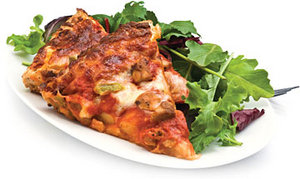Another way to fill the nutritional gaps in your daily diet is to take supplements. Whole-food multivitamins or nutrient replacements, like fish oil or calcium, can help you reach your health goals.
Some supplements are specifically designed for adults, children, men or women. Different people need different types of support, so check with your health care professional to see what will work best for you and your family.
Finally, one very important change you can make is to pack your child's lunch. Teaching healthy eating patterns sets children on a lifetime path of nutritional health. Prepared food producers know this; it's why they often target young children - to get them hooked for a lifetime. Also, while school lunch programs are incredibly important in meeting the needs of many children, they may not offer good meal choices. Making your child's lunch (and your own, while you're at it) does require more time and planning, but as it becomes a habit the benefit will outweigh your time spent. Aim for a balanced lunch of whole grains, fruit, vegetables, low-fat dairy and lean protein. Your child may not go for all those options at first, but every little bit helps, and you'll be planting seeds for their future good health.
Every Little Bit Helps
 Eating healthy is not always easy. Healthy options can be hard to find, hard to finance and hard to introduce into your family's diet. Trying to make healthy changes can seem overwhelming. The key point to remember is that every little bit helps. If you can't eliminate convenience food, make healthier choices in where and what type of food you eat (for example, baked vs. fried). Making gradual changes will give you time to develop new tastes and help you better understand what choices work best for your family. When you invest time now, you'll soon start to notice huge rewards.
Eating healthy is not always easy. Healthy options can be hard to find, hard to finance and hard to introduce into your family's diet. Trying to make healthy changes can seem overwhelming. The key point to remember is that every little bit helps. If you can't eliminate convenience food, make healthier choices in where and what type of food you eat (for example, baked vs. fried). Making gradual changes will give you time to develop new tastes and help you better understand what choices work best for your family. When you invest time now, you'll soon start to notice huge rewards.
Shopping Solutions
At the supermarket, remember to:
- Stop by the salad bar to throw together a quick salad.
- Buy some pre-cut fruit or vegetables for lunch and snack time.
- Pick up frozen fruit to have on hand for cereal or smoothies.
- Skip the chips and buy a variety of nuts to crunch on.
- Put the ice cream back and choose frozen yogurt, sorbet, or a fruit smoothie as a treat.
- Avoid trans fats or partially hydrogenated oils (found in things like restaurant foods, snack foods, vegetableshortening, and most crackers).
- Avoid high-fructose corn syrup (found in some sodas, juice drinks, condiments, and many other processed foods).
Sara Tiner, BA, BS, MS, is the coordinator of scientific communication for a whole-food supplement manufacturer in Wisconsin. With undergraduate degrees in biology and English from Ripon College, and a master's degree in journalism from Columbia University, she's worked as a science writer in both print and radio over the past decade, and moonlights as a freelance contributor to various publications.

